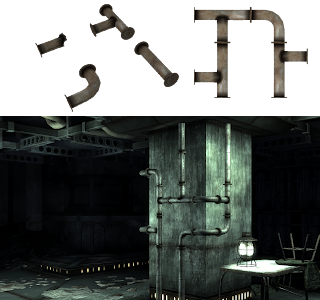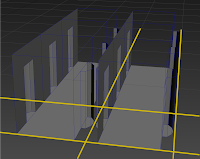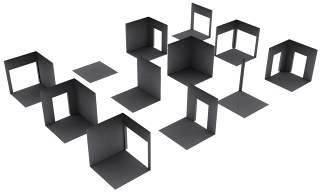
The first piece of documentation on modular models that I read was a blog post by Joel Burgess. The blog post is a transcript of a lecturer he held at GDC 2013 titled "Skyrim's Modular Level Design. Joel Burgess is currently employed as the Senior Designer for Bethesda Game Studios and worked on designing and implementing a modular approach to level design for Skyrim dungeons.
I first read this post last year when designing modular assets for our 2nd year unity project named "Loot the Dungeon". I was tasked with creating a set of interior building blocks for a dungeon, with the idea of it being able to create more levels later on in the project with as little effort and time as possible, which lead me to research into modular level design.
 I've decided to revisit this article, now with somewhat more experience while dealing with the idea's and issues with modular design. This article mainly focus's on what Bethesda call "kits". These kits are a collection of model assets that are designed to snap together like lego pieces, but these assets are capable of snapping to each other in ways that creates different possibility of its usage. This allows a few assets to be used multiple times throughout a game or scene but can be placed differently which makes the scene's or level layout varied thus achieving more value to the assets.
I've decided to revisit this article, now with somewhat more experience while dealing with the idea's and issues with modular design. This article mainly focus's on what Bethesda call "kits". These kits are a collection of model assets that are designed to snap together like lego pieces, but these assets are capable of snapping to each other in ways that creates different possibility of its usage. This allows a few assets to be used multiple times throughout a game or scene but can be placed differently which makes the scene's or level layout varied thus achieving more value to the assets.An example of this is a simple pipe asset kit which is only 4 pieces but each piece can be used in different ways with each other piece.
Joel explains the pro's and con's of modular level design in regards to a previous title he worked on, which is Oblivion, the precursor to Skyrim. Modular level design can help speed up the process of building new levels and scene's but can also reproduce very similar designs over and over which is apparent in Oblivion and became boring to players very quickly.
Kits can vary depending on their usage, but generally modular kits are a section of larger assets for a interior or exterior that can be used together to create a scene / level. Smaller kits such as the pipe example are also kits but refereed to as "sub-kits" as they will most likely be a small kit that works with the theme or design of larger kits.
To further increase the usage of kits, each kit is designed in the same way in terms of scaling and modularity which means you can use multiple kits in a scene to create even further variety thus further increasing the bang for buck. Joel gives an example of this with stating that two full time kit creators made 7 kits and the level designers managed to create 400 unique cells (levels), each kit had 50+ assets in them and contained several sub-kits and were all build on a standardized unit scale.
The method of creating modular asset kits and using them to design varied and interesting level designs comes through collaboration with both level designs and the artists creating these assets. Working closely together, its possible to come up with a standardized scaling and concept of how the assets will work together and what inpact that will have during the creation of them.
First Phase
Standardizing a scale or units in which the game will be created in is the base starting point. Units in game engines can vary but a good place to start with is first deciding how large a character in the game would be and using that as a guide for the rest of the environment. Setting up or understanding how the character / player will be interacting with the game environment is also key when making design choices for assets e.g.
- Character height - To scale other assets against (Walls etc)
- Min/Max width of rooms/paths - Allowing space to move around / fight AI
- Character incline angle - Stairs & Ramps
- Character jump height & distance - Assets that are design around a mechanics limitations
Second Phase
This phase is where the team will decide on specific design choices that will drive a kit to its next stage of development. These choices will determine specific guidelines and unique features that would need to be accounted for when proceeding with development.
- What is the visual theme of the kit?
- How is it different from other areas in the game?
- What kinds of spaces do you want to build with it?
- How will be it be used?
- How often will it be used?
Third Phase
 This phase is where you create the base prototype mesh's for the kits that will be used to design your levels. These assets will be very basic and only used for to prove the concept of the kit and ensure that any design flaws are found and dealt with prior to proceeding with development.
This phase is where you create the base prototype mesh's for the kits that will be used to design your levels. These assets will be very basic and only used for to prove the concept of the kit and ensure that any design flaws are found and dealt with prior to proceeding with development. A key thing to keep in mind in this stage is the "footprint" of kits and there sub-kits. Its recommended you create assets with the same scaling or at the power of two so that all the assets can link together seamlessly. Keeping assets equilateral is the easiest was around this but some assets that are unique or need to be a different shape need to be tested in this phase before continuing.
A key thing to keep in mind in this stage is the "footprint" of kits and there sub-kits. Its recommended you create assets with the same scaling or at the power of two so that all the assets can link together seamlessly. Keeping assets equilateral is the easiest was around this but some assets that are unique or need to be a different shape need to be tested in this phase before continuing.
The reasoning behind what Bethesda call the footprint of an asset is so that all the assets are set within a specific grid space which allows the level designs to snap all of the assets together quickly and efficiently. If pieces of the assets are beyond this footprint / grid space, it may cause intersecting assets which can cause graphical glitches. Its recommended that modular assets are all designed within the specific grid spacing / footprint that is decided on during phase one.
 Fourth Phase
Fourth PhaseThis phase is the graybox phase, this is very much like phase three but the assets that are first created are the ones which will be most commonly be used and followed by sub-kit assets that fit in with the primary modular assets for further testing prior to sending these assets off to art.
This is also where naming convention for assets is set, with kits that have possibly 100's of assets in them, the naming of them is very important for level designers to build fast and efficiently. Skyrims naming conventions is labeled depending on what kit the assets belong to, what they are and any other information that is relevant to that piece (rotation etc).
Summary
This is a very interesting and in depth article which still has a lot of information for me to take from. I feel it best to leave this article at this point and continue my search for more relevant information regarding the theory behind and design choices of modular asset kits. I'll likely split this into a 2 part post as there is information about Bethesda's approach to off grid modular design and information on issues while working on the vertical axis as well as sub-kit assets that need a reference point.
A vast majority of the things mentioned in this article I have already tried and tested last year in the development of "Loot the Dungeon" and my 3D modelling assignment but there we're some specific issues I had with both of them and re reading this article has helped clarify Bethesda's solution and given me some idea's on how I could of done it myself.
Reference
- Joel Burgess. (2013). Skyrim's Modular Level Design. Available: http://www.gamasutra.com/blogs/JoelBurgess/20130501/191514/Skyrims_Modular_Approach_to_Level_Design.php. Last accessed 19th Oct 2014.


No comments:
Post a Comment